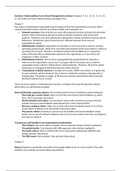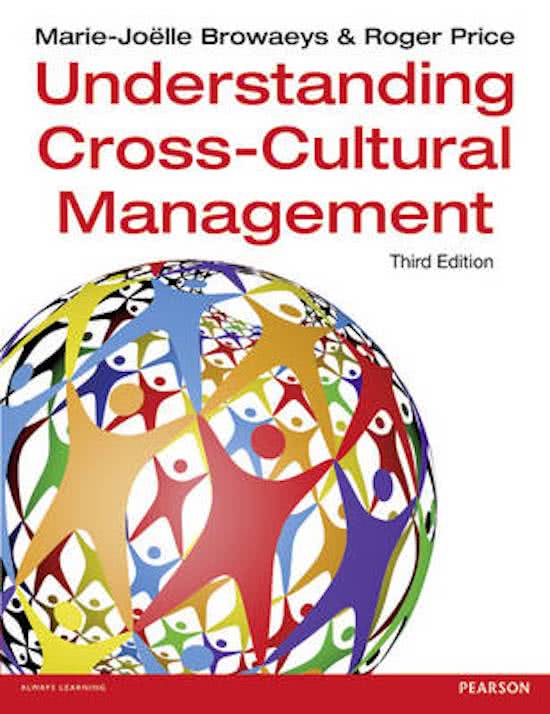Summary Understanding Cross Cultural Management summary (chapters 7, 8, 9, 10, 11, 12, 15, 16,
17, 18) written by Marie-Joëlle Browaeys and Roger Price
Chapter 7
The stages of development organisations go through and how this organisational structure affect
cultural interaction/culture diversity according to Adler and Gundersen are:
1. Domestic structure: firms with this structure offer products/services exclusively to domestic
market. If they sell products abroad, its because foreign customers want to buy their
products. Therefore, they have ethnocentric perspective without sensitivity towards cultural
differences. Worldwide cultural diversity hasn’t affected domestic firms internal
organisational culture
2. Multidomestic structure: organisation is presented as set of sub-units in several countries
operating autonomously. These firms must take particularities of the local market in which its
operating into account. Therefore, sensitivity towards cultural differences is important.
Cultural diversity affects relationships external to the organisation as it has clients and
employees in other countries
3. Multinational structure: this structure is geographically spread therefore; diversity is
inherent to the organisation concerned. A company with this structure has an internal
organisation whose culture is influenced by cultural diversity. Therefore, these firms attach
importance to managing multinational diversity within the firm.
4. Transnational or global structure: final type of structure. Differs from others as it generates
its own evolution without having to rely on forces outside the company. Heterogeneity is
indispensable. The global strategies of HR become essential and diversity allows mutually
beneficial relations to be created
These are seen as phases of development, because a company has to go through these phases
before they can call themselves global.
Deal and Kennedy corporate cultures (risk involved and how time is needed to receive feedback):
- The tough guy, macho culture: takes a lot of risks and receives quick feedback e.g. police
force. Find a mountain and climb it.
- Work hard/play hard culture: fun and action culture with a tendency to pursue low risk
activities that give quick feedback. Sales department. Find a need and fill it.
- Bet-your-company culture: takes a lot of risks and receives feedback slowly. A lot of time
passes before employees see the benefit of decisions taken.
- The process culture: tendency to pursue low risk activities and receive feedback slowly,
banks. Due to lack of feedback employees forced not to worry about what they are doing but
how they are doing it.
Trompenaars and Woolliams and organisational relationships:
- The incubator: like team without a leader. Person-oriented. People oriented, egalitarian
- The guided missile: Task oriented with MBO approach, task oriented, egalitarian
- The family culture: Power oriented with stress of personal relationships (affinity/trust)
People oriented, hierarchical
- The Eiffel tower: Role oriented. Task oriented, hierarchical
Chapter 8
Theory X: based on pessimistic assumption that people dislike work, do a lot to avoid it. They lack
ambition and creativity and avoid taking responsibility.
, Theory X manager: is results-driven, has little interest in human issues. Doesn’t listen to suggestions
for improvement. The manager is task-oriented: he ensures effective performance of the company
Theory Y: based on optimistic approach that people actually like working under suitable conditions;
they are willing to accept responsibility, are creative and imaginative
Theory Y manager: wants employees to participate in decision-making and problem-solving. The
manager is relationship oriented: he ensures greater satisfaction among subordinates
Z-theory: Extension of Y-theory with features of modern Japanese management. Reflects Japanese
concept of wa (the notion of harmony), assumes employees are disciplined, have moral obligation to
work hard, want to establish close relations with their colleagues and bosses.
Fielder’s contingency theory: considers the interaction of two factors: leadership style and
situational favourableness. Leadership effectiveness is the result of interaction between the style of
the leader and the characteristics of the environment in which the leader works.
This environment is characterised by three factors:
- Leader-member relationship: the degree of confidence, trust and respect
- Task structure: the extent to which it is necessary to spell out the goals, guidelines and
procedures to the workers
- Position power: the extent to which the leader or the group holds the power.
implication of this approach is that there’s no answer as to what makes an effective leader
Fiedler presents two extreme situation describing all contingent factors which are:
- Highly favourable situation – everyone gets along well, tasks are clear, leader enjoys
considerable power
- Highly unfavourable situation – leader has battle of wills with workforce, tasks not
structured, leader needs to be strong to counterbalance power of the workforce
The value of Fielder’s contingency theory in comparison with X-Y is that according to Fiedler,
leadership effectiveness is the result of interaction between the style of the leader and the
characteristics of the environment in which the leader works. This situational favourableness, the
influence of different situations in which a leader may operate and how these affect the effectiveness
of the leader, was missing in the X-Y theory.
Transformational leader: creates, communicates and embodies a vision that can influence changes
in the attitudes and assumptions of subordinates, builds their commitment to the organisation and
inspires trust, confidence and loyalty
Transactional leader: has more of a business-like relation with subordinates, a give-and-take
approach whereby the concerns of the company as well as the employees are protected.
The Global Leadership and Organizational Behaviour Effectiveness Project (GLOBE project)
determined 6 global leadership dimensions which summarise characterises perceived culturally to
further or impede effective leadership:
- Charismatic/value-based leadership: reflects ability to inspire, motivate and to expect high
performance outcomes from others.
- Team-oriented leadership: reflects effective team-building and implementation of a common
goal among team-members.
- Participative leadership: reflects degree to which managers involve others in making and
implementing decisions.
- Humane-oriented leadership: reflects supportive and considerate leadership but also
includes compassion and generosity.





